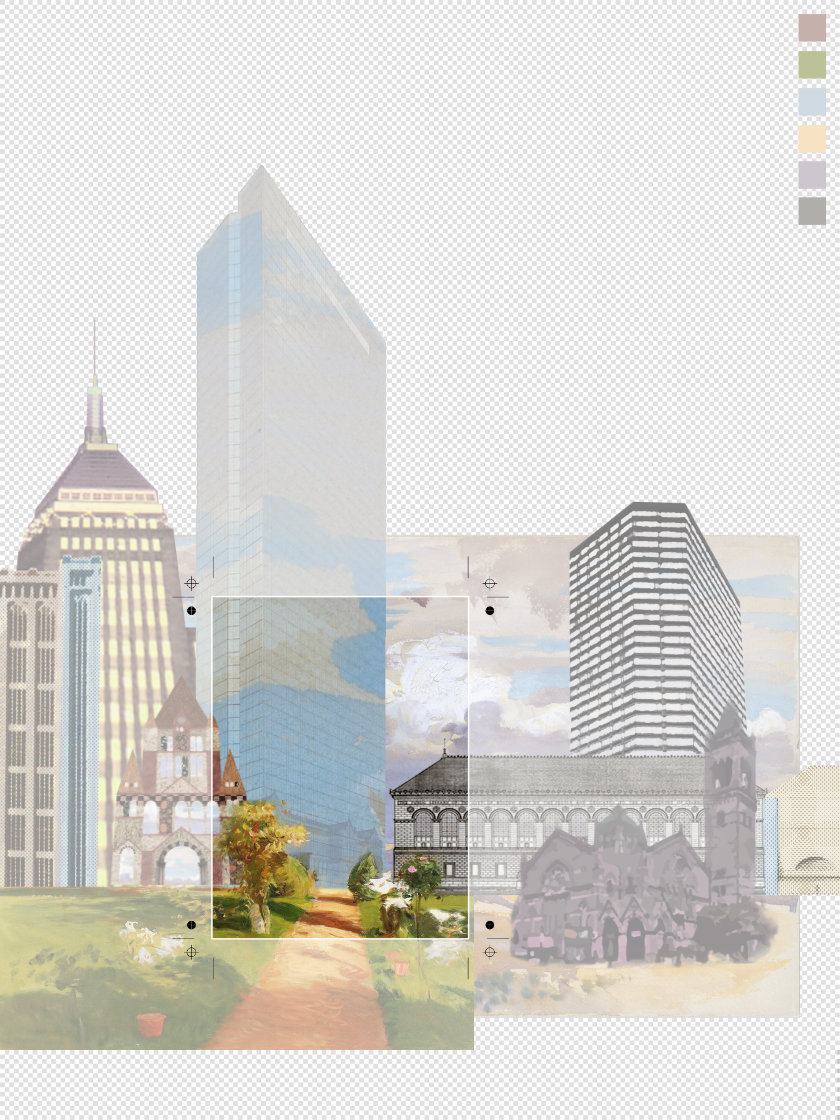


This trilogy may define Copley, but even by basic geometry it cannot complete the Square. In fact, the three take just two sides and a corner. The remaining edges, corners and adjacencies showcase even more architectural philosophies. An assortment of low- and mid-rise buildings populate the northern edge of the Square. Philip Johnson shows up behind the Boston Public Library with a principled extension that echoes the original and finds within structure for much more. Across the Square, as the backdrop of Trinity Church, Johnson appears again with 500 Boylston, an office tower that sets back to align with Trinity's steeple through cheeky Renaissance allusions. Both do the trick, but that's Johnson's game: turning tricks. Also present twice is the hand of of Ralph Adams Cram, the architect responsible for countless Gothic cathedrals and college campuses in the United States. His firm, which continued operation after his death, leaves the two Art Deco offices that flank Trinity Church: the New England and Berkeley Buildings. Along the Square's south, Henry Janeway Hardenbergh replaces the Museum of Fine Arts with a procedural hotel — a Beaux-Arts wannabe that gets the job done. Across the street from both Hardenbergh and McKim, The Architects Collaborative upgrade their schooling from the Beaux-Artes to the Bauhaus and Gropius' Harvard. And of course, there is the cantankerous Old South Church.
Already, though, we watch Copley creep farther and farther from the Square. Its moment of confrontation extends across the architecturally young and lively Back Bay until its scale fades into the urban fabrics of Boston. Boundaries must be drawn, and foci chosen. The triumvirate of Richardson, McKim and Cobb presents itself not only as the cream of Copley's crop, but as oppositional theories of how to create architecture. In the Vitruvian triad, the ancient underpinning of architectural theory, each dismisses a point: Richardson repeats an array of aesthetics and utilities, structuring them together in the aftermath; meanwhile McKim borrows from a repertoire of structures and aesthetics to explore a new utility; and finally, Cobb focuses on his structure and its commercial utility to avoid the question of aesthetics. Or, by revised 19th-century theory, they are simply gothic, classical and modern (or, somewhat pedantically, their neo- counterparts). Or maximal, moderate, minimal. Small, medium, large. Again, the list never ends.
Robust as this variety of architectural thought is, the Square holds only one urban moment wrought with its own situational limitations. As reclaimed land in the business center of New England, both its architects and its occupants are historically educated, privileged and gregarious. They talk over other conversations that seek to give more to architecture's definition than abstract notions of its conception, desire and possibilities, and lead many unwitting critics into doing the same.1 The conversation has been had many times over; the last major contribution, Cobb's Hancock, is nearing fifty years old. Countless students of architecture visit Copley Square to muse over its masters as they do the great squares of Mexico City, Venice and Beijing. As many Bostonian students till its rich soils, the Square leaves one to wonder what will grow here next to balance the ecosystem. Which fourth quarter will complete the Square until its diagonal renders another quintile conceivable, et cetera?
In the middle of the night, after the T has stopped running and only the snowplows roam the streets — scraping salty slush into mounds along the sidewalk to barricade unpresent pedestrians — the conversation continues without an audience. The blanket of snow between the berms will provide fodder for the children who will take over the Square come sunrise, the howl of the wind giving way to the shrieks of snow down the back. Between this ambivalent alliance of buildings, the city spins on. Copley's architectures, disparate as they may be, resign themselves to the background of whatever their occupants choose to discuss.
# Date [Return to] Title
500+ Ongoing Essays
550 May 2023 Platform Gamification
504 December 2022 On the Grid
518 December 2022 A Suspended Moment
A–Z Ongoing Glossary
G September 2022 – as in Girder
F May 2022 – as in Formal
* April 2022 – Key
E February 2022 – as in Entablature
D November 2021 – as in Duck
C August 2021 – as in Czarchitect
B June 2021 – as in Balustrade
A April 2021 – as in Aalto
0–15 December 2020 Journal
15 November 2020 Practice (in Theory)
14 October 2020 Alternative Narratives beyond Angkor
13 September 2020 Urban Preservation in Cuba
12e August 2020 Conversation on Copley Square: Summations
12d July 2020 Conversation on Copley Square: Conceptions
12c June 2020 Conversation on Copley Square: Reflections
12b June 2020 Conversation on Copley Square: Nonfictions
12a May 2020 Conversation on Copley Square: Foundations
11 May 2020 Out of OFFICE
10 March 2020 Hudson Yards from the High Line
9 March 2020 Metastructures
8 February 2020 Form, Program and Movements
7 February 2020 Life in the Ruins of Ruins
6 January 2020 The Urban Improvise
5 January 2020 Having Learned from Las Vegas, or Moving past Macau
4 December 2019 A Retrospective on the Decade's Spaces
3 December 2019 The Captive Global City
2 November 2019 Temporal Layers in Archaeological Space
1 November 2019 Contemporary Art Museums as Sculptures in the Field
0 Undated Manifesto: A Loose Architecture
© 2019 – 2023 Win Overholser
Comments
Loading comments...
Powered by HTML Comment Box.